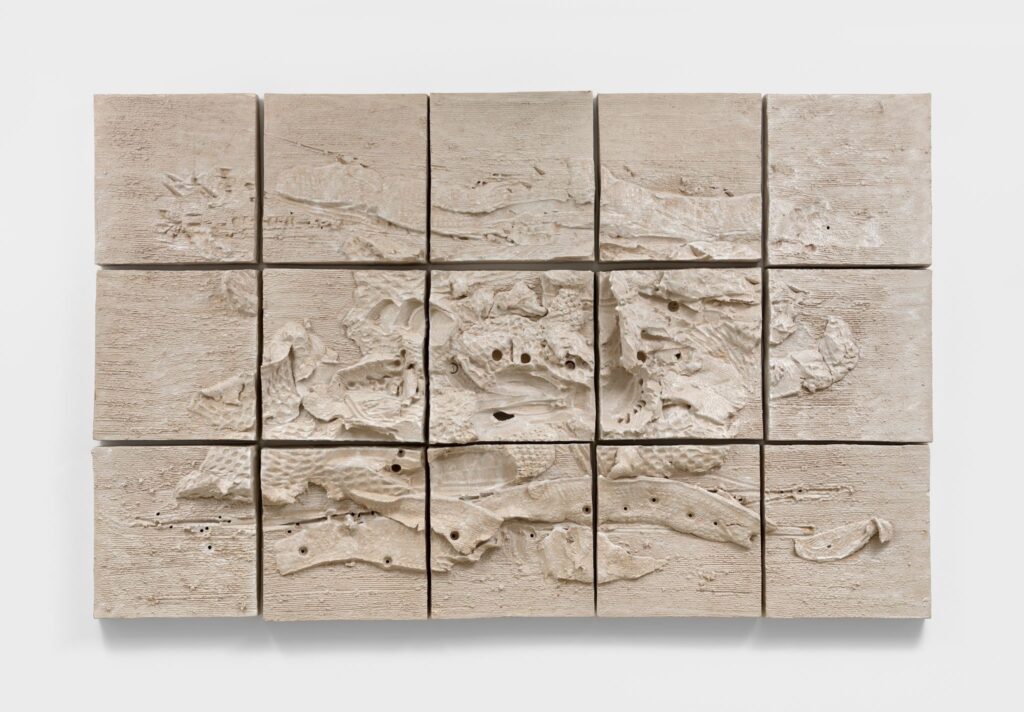Ekin Erkan on Wall-based Reliefs in The Brooklyn Rail, October 2025
Ekin Erkan reviews Slabs and Boards in The Brooklyn Rail, October 2025

Almine Rech’s two-person show, Erik Lindman & Augustus Thompson: Slabs and Boards evidences that the connective tissue between the two artists’ sculptures consists in the subtending quadrilateral plane, which Lindman and Thompson instrumentalize in dichotomous modes. Lindman tiles his rectangular surfaces with square trestles that cradle his deliquescent protrusions. Their caliginous folds and recesses, built out towards the viewer’s perceptual field, rake a soft dance of suety shadows along the orthogonal substrate below. Reminiscent of macramé designs, Lindman’s gray honeycombed forms wend in and out of the modular platform. Such is the case in the spiraling scale furrows of his well-executed Ryggen (all works 2025), whose polysemous title at once refers to the Danish word for “back” and the Norwegian-Swedish textile artist, Hannah Ryggen (known for her figurative woven tapestries). Ryggen’s kneaded silvery emulsions, which resemble an overwalked marshland’s ashen gley, are suspended in a six-part vertical grid.
In his momentous, buff-washed sienna scaffolding, The Bell, Lindman horizontally shifts his modular arrangement. Thick ceramic sweeps, dragged across the surface, are quadrated into the three-by-five matrix’s lower-third. The Bell and Lindman’s other planar sculptures, fit with gesturally palmed-and-cleaved clay pewter nodules, are particularly effective due to the tension elicited by the square ashlar support staging bulbous and unmanaged surface forms. There is less productive tension to be found in Thompson’s uniformly flat linen platforms. Indeed, Lindman’s mired mounds, which admit gestural swaths, are almost at odds with Thompson’s smoothly imprinted recumbent surfaces. While Lindman’s coarse mosaic arrangements suggest cragged, time-worn funerary steles, marshy loams, ambled-over mudflats, or silver swamps swept by leaden tides, Thompson’s level boards, soaked with tree ring and bark knot patterns riven by flat color fields, appear far more built. This is despite their organic motifs, which, at most, produce subtler, more formally disclosed juxtaposition. In Lindman’s sculptures, however, material opposition-cum-tensity is made substantive and corporeal.
The two artists also occupy opposite poles in terms of color. Lindman traffics in monochromatic grays and ochres, with tonal variance emerging only from the material’s pocketed crevices. In Thompson’s case, the wood-veined furrows of Red fire pipe, Take chair home, and Graphs about death and graphs about perfect freedom are, respectively, laminated into brightly glossed ultramarine, carmine, or amber rectangle sheets. Thompson’s most successful works are those like Dump run pipe universe, where the naturalist representations are sequestered within board-shaped laterals that divide a broad-spanning and uniform color field. Here, a triad of fissure-graven laths sunder the glaucous field into uneven triads.

In Lindman’s preparative materials for the exhibition, the artist underscores the unplanned nature of his stoneware slab sculptures. This is evident in their being punctured and punctuated with gapes of variable sizes. Lindman cites Lucio Fontana’s stippled ovoid forms as one of his art historical influences. Fontana, however, used the void to focalize empty space, whereas Lindman’s fissures are subsidiary to the ceramic piles that they cleave. In his own exegesis, Lindman leans towards a more phenomenological register than Fontana, deeming his wall-based reliefs as “haptic” engagements of planar composition. While Fontana’s forms may be a significant influence on Lindman, so too are Asger Jorn’s Helhesten- and CoBrA-era painted tile reliefs. Like Jorn, Lindman’s scabrous surfaces suggest an expressionist bent, evinced by the artist’s additive sculpting technique. His reliefs involve stretching and dashing wet, inchoate clay into textural forms that are subsequently strewn onto a base then pierced by carved-in apertures.
Lindman also cites the Norwegian neo-Romantic landscape and marine painter, Peder Balke, as an important precedent, noting that Balke’s mottled surfaces were, similarly, the byproduct of an unplanned process. Here, Lindman’s work recalls the expression theory of philosopher Jenefer Robinson. Amending R.G. Collingwood’s treatment in The Principles of Art (1938), Robinson avers that Expressionist artworks effectively articulate the artist’s emotional state. Collingwood, at pains to distinguish “art proper” from mere technē/craft, sought to delineate art as necessarily consisting in working out a feeling or thought that evolves as the artist executes their artwork. Collingwood remarked that “from this helpless and oppressed condition,” the artist “extricates himself by doing something which we call expressing himself.” Collingwood’s expression theory embodies the Romantic idea that the main function of art is to express an artist’s emotion. Robinson, producing a novel Romantic theory of artistic expression according to which artworks can, via their structural features, express the emotions of their creator, argues that “expressive qualities are qualities that can be grasped through the emotions they arouse,” where these ought not and cannot be reduced to folk-psychological emotion words.

This framework certainly does not apply to Thompson’s more austere and formalist paintings. But it strikes me that Lindman’s work suitably lends itself to Robinson’s expression theory. His heavy ceramic forms, with their air-pocked holes and stroke-dashed rivulets, communicate such elliptical expressive qualities with profound vigor; they have to do with, but cannot be reduced to, mankind’s weary movement forwards—a trudging-and-tugging, a struggle with one’s own heaving, tired weight. That Lindman has effectively aroused such emotive qualities with his recent series of sculptures is a serious testament to his artistic development.